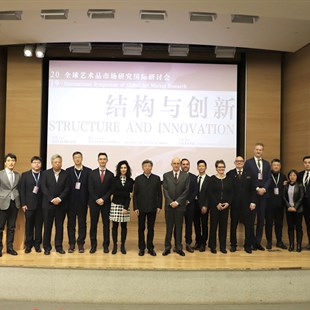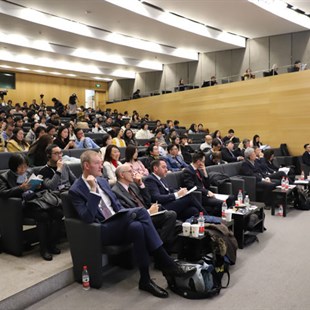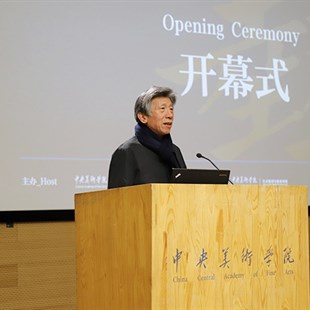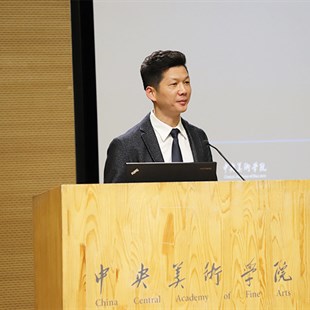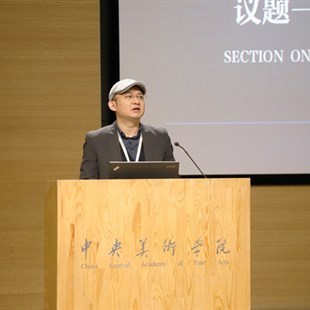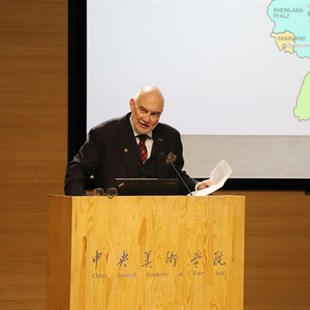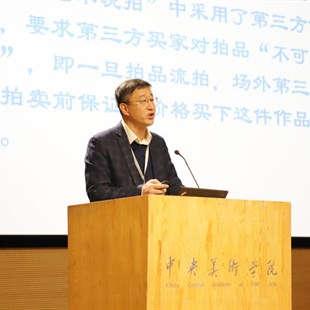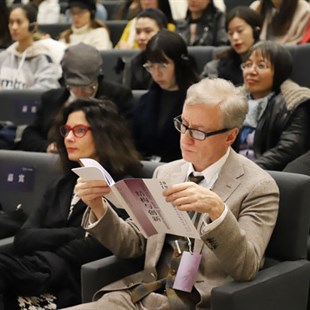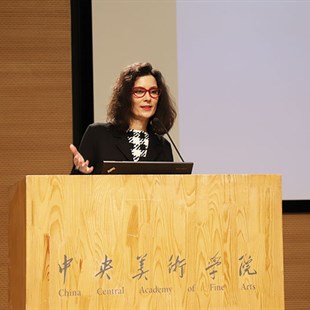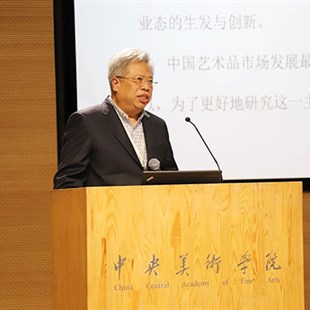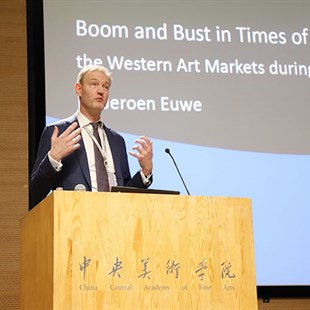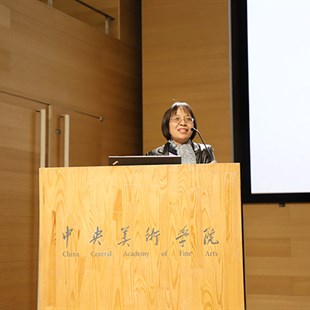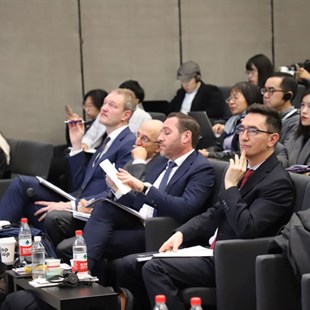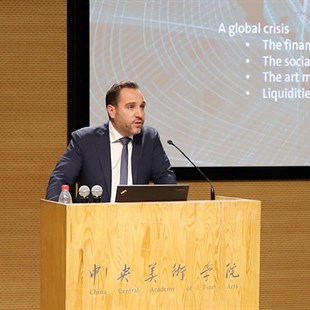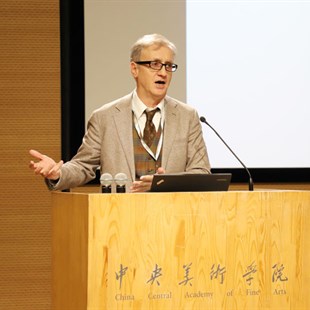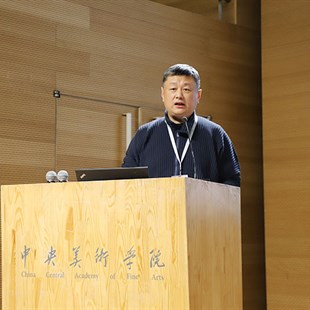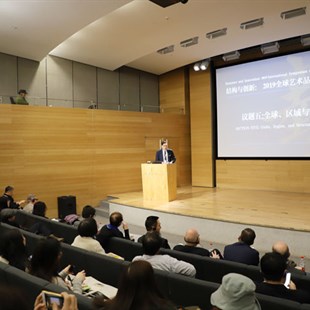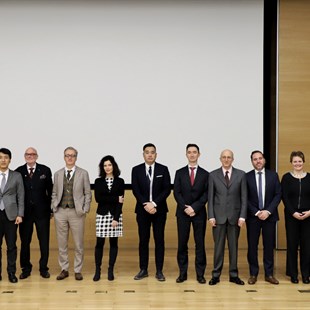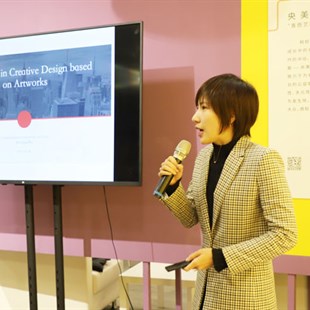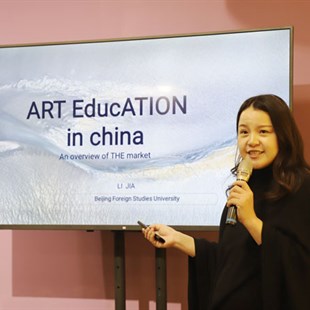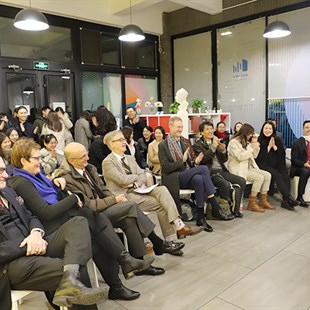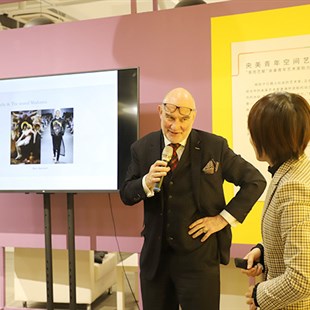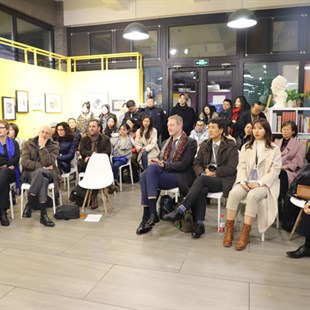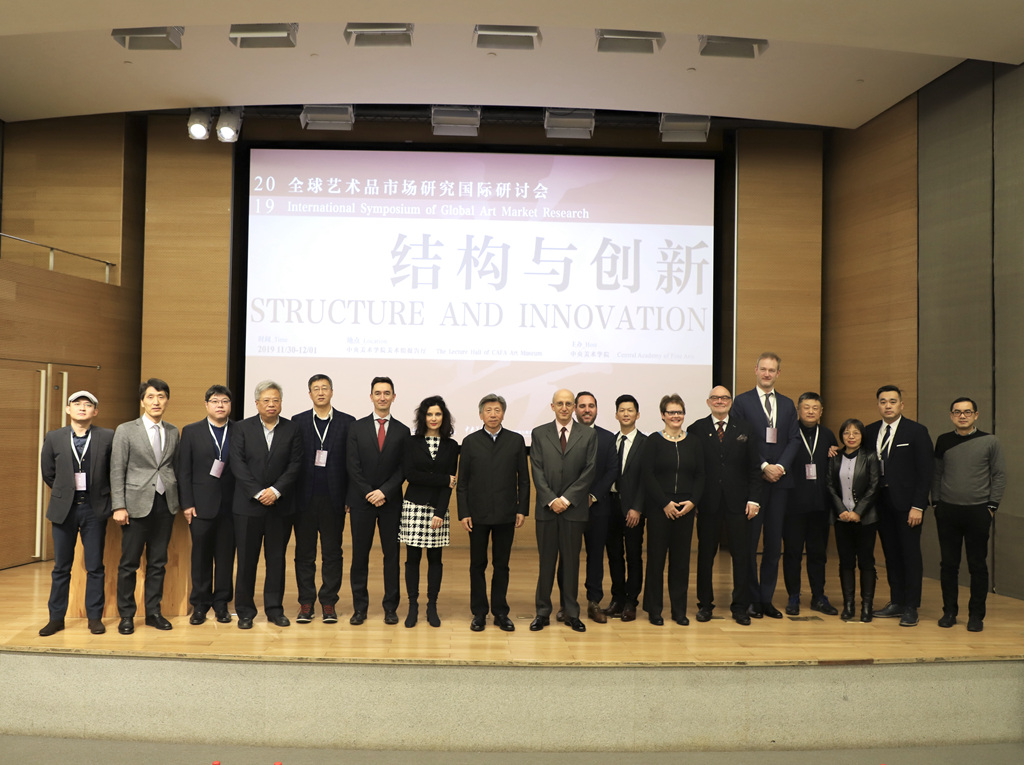
The snow-covered lecture hall of the Central Academy of Fine Arts Museum was filled with guests. From 30 November to 1 December 2019, the Structure and Innovation: 2019 International Symposium of Global Art Market Research was successfully held at the Central Academy of Fine Arts. This symposium was jointly organized by the School of Arts Administration and Education, CAFA and TIAMSA CHINA. 20 representative academic researchers from China, Germany, Italy, the Netherlands, Switzerland, the United Kingdom, France, Poland, South Korea and other countries and regions were invited to participate in this symposium. Centered on “structure and innovation”, this symposium shared the most cutting-edge, professional and in-depth art market research through lectures and discussed many topics from an international context, including the current international art market trends as well as regional competition and cooperation, business and service model innovation in the art market, art market and financial innovation, technological innovation in the art market, operation innovation in art market institutions and globalization of art market research.
At the beginning of the symposium, Professor Fan Di’an, President of CAFA, welcomed the experts and scholars from home and abroad on behalf of CAFA, and delivered an important speech to launch the symposium. “The art market is often compared to a ‘barometer’ for economic development.” He said that with the rapid development of the global economy as well as culture and art, the art market is drawing more and more attention from all walks of life and that the Chinese art market has also seen developments since entering the 21st century and has become one of the top three art trading bodies in the world. In this context, this international symposium for global art market research held at CAFA, when the Chinese art market is facing transformation and upgrading and CAFA ushers in its new century, will become a landmark exchange and discussion for the research on the Chinese, even global art market.
President Fan Di’an also emphasized that, it is China’s first university to offer the major in visual arts management, CAFA’s teachers and students and professional scholars from all over the world will exchange ideas on hot global academic topics, hoping to promote the classic theme of the art market into a new cultural context and economic environment. The results of the research and discussion from this symposium are the knowledge reserves for the cultivation of art management talent. “This is not only an academic research and symposium, but also a teaching exchange on talent cultivation. CAFA sincerely hopes, by taking the opportunity of this symposium and aiming at building a global art market research system, to build a broad platform for connecting the future Chinese art market and the global one.”
With the development of China’s cultural industry and art market, there is a trend for China’s art market to become larger and more diversified, international, technological and financial. The consumption of artworks has been upgraded, the wealth management of artworks is of concern and the demand for market construction is increasing. All this has brought new risks and opportunities to the Chinese, even the global art market. Facing such opportunities and challenges, Professor Huang Yong, Deputy President of the School of Arts Administration and Education, CAFA, admitted that with the global economic integration and the deep development of the Chinese art industry, the emerging market of the art market is simultaneously conducting a global spread and self-renovation. Changes such as innovative and diversified business models, coordinated online and offline development, improved supporting systems, and blockchain technology exploration help promote the sustainable development of the art market in China. At the end of his speech, Professor Huang Yong expressed the original aspiration and purpose of the symposium: “In the art management discipline system, art market research is one of the most active and high-profile areas and a hot discipline with great potential. Under such a discipline background, the School of Arts Administration and Education, CAFA aims to share experience with an open mind and join hands with experts and scholars to discuss the trends and development of the art market, so as to inject vitality into the healthy development of the Chinese and global art market.”
[Institutional Analysis] of Laws, Regulations, and Market Formation
Based on the practice of art markets in various countries around the world, the construction of art management systems, art laws and regulations and the market situation as the basic guarantee system of the market are topics that are currently unavoidable when it comes to how to ensure the normal operation of the art market.
Peter M. Lynen, a professor at the North Rhine-Westphalia Institute of Science and Art in Germany, through the research in the national art markets of the federal governments represented by Germany, presented the current state of the Western traditional art market, art management and art marketing system to the audience and tried to explore the possibility of analyzing the art market from an institutional level.
Based on the basic thesis that artworks are of a commodity nature along with the current state of the German art market, Peter M. Lynen conducted in-depth research in the social and institutional levels of the art market from vertical and horizontal perspectives. From the vertical perspective, Professor Lynen analyzed the intrinsic causes of German art mechanism from three social levels: the state and government, the cultural creativity industry and citizen groups. Professor Lynen mentioned in his speech that since the establishment of the federal government system, the German art market has been subject to multiple layers of control from the national government, state governments, cultural departments and many other forces. On the one hand, this makes Germany’s art market extremely regionally diverse. Art institutions and art markets located in different regions have very different patterns; on the other hand, art institutions and projects can also get more funding and policy support from different levels. From the horizontal perspective, using detailed data as a support, Professor Lynen enumerated the differences in the market performance of German arts in various regions and categories and made a comprehensive analysis of the causes of the current situation of the German art market according to the views based on the previous analysis on three social levels.
When talking about topics that the Chinese and German art markets should pay attention to in the future, Professor Lynen said: “Because of the different systems in many ways in China and Germany, the art market conditions in the two countries are quite different. However, regarding the institutional and legal construction of art markets, both should pay attention to the possible trend of ‘the guiding role of civil society in the art market’. From the legal perspective, whether it is a natural person, a legal person, or an NGO or NPO, these basic legal concepts in ‘civil society’ represent different art operating modes. In the future, the clarity of ‘civil society’ will further affect the establishment of art market rules.”
Professor Liu Shuangzhou, Dean of the School of Culture and Media and Director of the Auction Center, Central University of Finance and Economics, spoke on the predicament and innovation of the financial art system in China. Focusing on the issue of “systems, regulations, and market formation”, Professor Liu Shuangzhou first analyzed the current status of China’s current art-related laws and the financial art system. Combining data from years of research, Professor Liu Shuangzhou pointed out that due to the inadequacy of the Chinese legal system in the art field, China has not yet issued relevant laws specifically for art. There is a “congenital deficiency” in the establishment of the operating system of the art market. At present, the basis for the operation of the art market is mainly based on “non-legal constraints” based on national policies. He also emphasized the “reconsideration” of the financial art system. “Because of the special nature of art finance, the existing blank fields may be left blank for a long time, which is a reality that the entire financial art field must accept. But the legislative blank does not affect the development of the finance of art. There are some laws to abide by for the operation of the finance of art, but what we lack is a targeted institutional arrangement.”
Professor Liu Shuangzhou also gave his own explanation on how to solve the practical operation problem derived from “reconsideration”: “The financial art system innovation should be based on three levels. Macro system innovation is aimed at policies and regulations, meso system innovation at supporting systems and micro system innovation at business models. What is most likely to achieve effective innovation at present is micro system innovation.” In terms of the preliminary practice of the financial art market, the needs of industry development and the micro business areas such as the artwork insurance, the artwork fund trust and the artwork quality pledge and financing, Professor Liu Shuangzhou shared many cases such as AXA Insurance Company, Artist Common Trust Fund APT and Weifang Bank’s pre-purchaser system, further explaining the feasibility and necessity of a micro system innovation to the audience.
Professor Liu Shuangzhou called on art finance personnel to step out of their mindset, and expressed his ardent expectation for the future transformation of the finance of art system: “The change in mindset is the premise of innovation. The market demand is the direction of innovation, efficiency and safety which are the standards of innovation and legitimacy in purpose is the bottom line of innovation.”
[Asset Analysis] Assets, Value, and Evaluation System
Since art investment is an important way to preserve the value of tangible assets, the evaluation of artworks is always one of the most concerning topics in the art market. The market behaviors and phenomena caused by artworks as commodities have also been repeatedly discussed by the academic community. How is an artwork valued as an asset? How does the value of an artwork keep stable or increase in market behavior? How can we establish an assessment system for artwork value and how can it produce fairness? What impact will the valuation of art assets have on the development of the art market? Chinese and Italian research scholars have respectively given their own answers.
Dr. Alessia Zorloni, Executive Director of Art Market Management at IULM University of Milan, Italy, initiated discussion of this issue from a unique perspective: the relationship between the establishment of private museums and public institutions, focusing on “the impact of private wealth in the international art market”.
In the past few years, Alessia Zorloni has focused on private art museums that are internationally influential and open to the public and whose founders are alive, researching on three interrelated issues: what motivates art collectors to establish private museums? How do private museums position themselves in local and global cultural fields through acquisitions and exhibitions? What impact do private museums have on the art market and public museums?
Dr. Zorloni conducted qualitative and quantitative research on private museums that fit her delimitation, focusing on the rise of private museums in Europe, the United States, Brazil, Russia, India and China. Combining her research data and results, Dr. Zorloni analyzed the reasons for the rise of private museums in recent years in her speech: First, a considerable number of works in public museums are difficult to be seen by the audience in many cases. Therefore, although private collectors have the desire to reach agreements with public museums, it is often difficult to truly form cooperation; 2. Collectors want to protect their intangible assets and carry on cultural heritage; 3. Collectors want to distinguish their cultural tastes from those of public museums and make their aesthetic values have an impact on the public.
At the end of her speech, Dr. Zorloni talked about the relationships between private museums and markets as well as public museums from a business perspective. “In the past 15 years, private museums have changed dramatically. They are no longer limited to behind-the-scenes roles, but are actively engaged in production. Compared to public museums, private museums have greater independence, especially at the ideological level. The rise of private museums, from the perspective of museology, is a supplement to the aesthetics and institutional structure of traditional public museums. But their market significance is even more remarkable. They are usually highly associated with high-net-worth individuals and often have very good personal relationships with artists. To a certain extent, the owner of a private museum can react to the market and guide the aesthetic taste of the market, thereby encouraging innovation in artistic creation.”
Professor Jia Gao (Xi Mu), President and Researcher of China Art Economics Research Institute and Vice-president of China’s Academy for Art Industries (Shanghai University), taking the Chinese art market as the observation center, expressed his unique insight on artwork trading and art wealth management.
With the expansion of the scale of the market and structural adjustment, art as a high-quality asset continues to promote the development of the art capital market, and the wealth value of art makes people pay more attention to their corresponding financing methods which makes financial art services gradually become an important driving force for the development of the art market. Through data, Professor Jia Gao (Xi Mu) compared the differences between the Chinese art trading system and the Western art trading system represented by the United States and concluded that there is a situation of imbalance, such as "the primary market of the Chinese art market being marginalized, the secondary market being dominant with the fair starting late”. He also found the trend that China’s emerging special trading models such as new e-commerce represented by new (integrated) media, “platform + trend” and “platform + art assets management” as well, featured transaction models such as huge private transactions, are developing rapidly.
Combining the cultural policies and related market performances that China introduced in the past, Professor Jia Gao (Xi Mu) proposed four major issues that have emerged in the Chinese art market since the reform and opening up: integrity mechanism, pricing mechanism, exit mechanism, and supporting service system. “It can be seen that the art market itself cannot completely solve the above problems. Based on this main development line of art trading system and the art market with distinctive Chinese characteristics, China should establish a trading service system that accords with the national conditions.” Professor Jia Gao (Xi Mu) proposed that from the commercialization of art to the present stage, the personnel of financial art services should promote capitalization of art, and then move towards financial realization and even security (popularization), and use this as a breakthrough to pull the art market out of the bottleneck. He also further emphasized the significance of the rise of the art wealth management business and placed high hopes on the future development of this field.
[History Analysis] History, Aesthetic Consumption and Market Transactions
In the past discussions on the art market, the important role of art market history in the construction of art market disciplines is often ignored, but when we look at the development of the art market from an historical perspective, it is not difficult to find that the art market, whether in the past or the present, has never existed in isolation. The topics surrounding the art market and art commerce have never been limited to art and aesthetics. At this symposium, Jeroen Euwe, Professor of Economic History and International Relations at Erasmus University of Rotterdam, Netherlands and Professor Wu Mingdi, a doctoral supervisor of College of Fine Arts, Capital Normal University, exchanged academic thoughts based on the history of the Western and Chinese art markets, analyzing and inferring the art market phenomenon in certain historical periods in China and the West in terms of economic history, history of collecting, market history and trading history and provided more ways of thinking on how aesthetics can promote the market and how art can reflect value in society.
Professor Jeroen Euwe, Professor of Economic History and International Relations, Erasmus University, Rotterdam, Netherlands, gave a keynote speech entitled Prosperity and Depression in Political and Economic Crises: Western Art Market in the First Half of the 20th Century. Taking the western art market from late 19th century to the first half of the 20th century as an example, he expounded the two different trends of the western art market in the period of war and the peaceful era, so as to further explore the profound factors affecting the art market.
Prof. Jeroen Euwe analyzed, mainly through the analysis of data and charts, that the changes in the western art market in the 19th century before the outbreak of the war were mainly influenced by the development of art intermediaries and the internationalization of the art market. This made the intermediary mechanism represented by art brokers more and more important in the western art market in the late 19th century, mainly manifested in the increase of the number of art intermediaries, a cluster of existence and specialization. Things changed a lot in the 20th century, when the war played a decisive role in the prosperity and decline of the art market. But the war did not just have a negative impact on the art market. On the contrary, it promoted the development of art to some extent: “Art as an ideology greatly affected the market. In general, the market was affected by the national ideology at that time. The loss of many works during this period affected the art market in terms of price and quantity sold. At the same time, the adjustment of monetary policy during the war also directly caused these funds to flow to the art market. People were more willing to use art rather than paper money as a reserve for wealth preservation.”
Through the analysis of macroeconomics, Professor Jeroen Euwe summarized the trends of the art markets in various countries before and after the war. Many factors such as war finance, taxation, currency financing, employment and the black market were important ones affecting the art market.
Professor Wu Mingdi, a doctoral supervisor of College of Fine Arts, Capital Normal University, gave a speech with very oriental characteristics: Redology and Art Market Research: Viewing Chinese Nobles’ Collection and Transactions of Artworks in Medium-Term Qing Dynasty from the Dream of Red Mansions.
As a classic in Chinese classical literature, A Dream of Red Mansions covers all aspects of the life of the upper class from Yongzheng period to the early Qianlong period in the Qing Dynasty. Among them, there are many descriptions related to the art market, but this part of the text has not attracted the attention of the Redology researchers. By digging into the relevant materials in Dream of Red Mansions, Professor Wu Mingdi explored the art collection and trading issues of the noble class in the mid-term of the Qing Dynasty, including collecting types, collecting concepts, trading venues and trading methods, so as to explore the aesthetic taste and circulation mode of artworks in the Qing Dynasty.
By studying the art collection and trading status of the noble class of the mid-term of the Qing Dynasty through A Dream of Red Mansions, Professor Wu Mingdi teased out Cao Xueqin's collecting concept of "simple but not vulgar, straight but not clumsy" and the scholar-class's unique pursuit of fine, refined and elegant art in Chinese culture behind it. Starting from the text of a work and restoring the context of a particular era to examine the details and changes of the art market and art collection in history, Professor Wu Mingdi’s research methods expanded the reference dimension for people to consider and study the development of the art market.
[Technological Innovation] Technology Innovation, Cross-Industry Integration and Industrial Ecology
How does technology influence the development of art? The art market is an important vector for measuring future development trends. Professor Nicolas Galley, director of the Art Market Institute at the University of Zurich, Switzerland, discussed new technologies and globalization around the topic of New Technology and the Global Art Market: Traps and Future.
Professor Nicolas Galley outlined the development and changes of the art market in globalization. Globalization has narrowed the gap between cultures. New technologies can help develop the art market from a technical perspective, which is particularly evident in the spread of visual arts. Through case studies represented by Brazil, Russia, India and China, Professor Nicolas Galley believes that the unified global art market has been divided into countless local art markets with obvious characteristics. Where and how to trade has become an important measure of art globalization.
And technological progress directly affects and attempts to answer questions about art globalization. Social media, online sales, electronic money, blockchain and many other technologies continue to push the art market to globalize through technical means. But how does technology support art? Professor Nicolas Galley replied at the end of his speech: "Art is an image. We need to find some new ways to look at works. The meaning of globalization is to shorten the distance between people and make art closer to us, and we can use technology as a new tool to help us realize the globalization of art in the future."
Compared to Professor Nicolas Galley's more positive views, Ma Xuedong, director of investment at Jade Capital expressed his attitude at the beginning of his speech: everything remains doubtful about whether the new model can really bring new growth in art. Starting from the three parts of the art market, he analyzed the phenomena due to technology, including oligopoly and monopoly of super galleries, the privatization of the auction industry and the chain of the entire industry and the cross-continental chain with characteristics in expos. He also shared new business models emerging after the three kinds of institutions combining technological development.
By analyzing the data of the "Super Galleries" such as Gagosian, White Cube, David Zwirner, Perrotin, and Hauser & Wirth in recent years, Ma Xuedong proposed that technological changes have made these strong ones stronger and the market has become polarized. Although there appears a trend of data growth in a short period of time, in the long run, the predatory occupation of art resources by super galleries has caused damage to the overall ecology of the gallery industry, which is not good for the balance of the entire art market.
At the end of his speech, Ma Xuedong emphasized: "Creating demand is the instinct of business intermediaries. However, the underlying logic and structure of the art market transactions have not changed fundamentally. The essence of the art market is establishing a bridge between people connecting the spirit, emotions and money via artworks."
[Structural Analysis] Global, Regional and Structural Changes
Among the previous topics, there had been many discussions concerning globalization issues. Professor Iain Robertson, director of the Art Trade Department of the Sotheby’s Institute of Art in the UK, gave a speech entitled Challenges Facing the Art Market in the 21st Century, which more systematically discussed future trends and possibilities of the global art market from the aspects of cultural rise, new technology and political economy, focusing on his personal research interest -- the rise of Asian culture.
Professor Iain Robertson first proposed that a considerable amount of the world's art wealth is now concentrated in Asia, a large part of which is in China. This conveys the message that contemporary art will change: New York is beginning to be replaced by Los Angeles, and the world’s economic center of gravity is leaning towards Beijing. With the extension of the “Belt and Road” to Central Asia, the development of Central Asia will become the focus of future art development. Countries and regions such as Pakistan and Saudi Arabia have huge potential...
From the perspective of new technology, there is no doubt that digital transactions have unique advantages in the art market, such as avoiding arbitrage, and preventing crime and counterfeiting. However, on the one hand, technology has reduced the opportunities for people to participate in art exhibitions; on the other hand, digital transactions have brought about a decrease in the demand for art transportation and the shrinking industry is likely to cause new crises and problems. Whether the involvement of technology can keep artworks away from art itself is still a question worth pondering.
From the perspective of political economy, the fullest development of technology will undoubtedly involve the monopoly of the oligopoly market, which will lead to deeper social problems such as reduced or increased job opportunities and changes in consumer behavior.
“In the diversified behaviors and ideas of the art market brought about by new technology, more and more differentiation is based on emotion and culture. Through technological development, issues such as cultural cooperation between art institutions and the return of artworks will enter a new phase. Correspondingly, people should pay more attention to issues related to culture and ideology. The rise of culture is of great significance to the art market.”
Professor Zhao Li, vice president and doctoral supervisor of the School of Arts Administration and Education, CAFA, tried to respond to the issues mentioned by the previous guests in his speech World and China: Globalization and Local Globalization of Art Market. Professor Zhao Li’s speech revolved around the two concepts of “global localization” and “local globalization”. The data proved that both the increasing purchasing power for artworks and the return of Chinese overseas artworks reflected the increasing dependence between different regions of the global art market.
Through a horizontal comparison of the Chinese and American art market data, Professor Zhao Li summarized the current state of China’s art market: the secondary market is active and the primary market is weak. What cannot be ignored is the influence of the auction market, the overall growth of which is relatively stable and some sectors have seen large gains. Although there are still shortcomings in terms of transaction rates, the future auction market enjoys an optimistic future. However, the gallery market is facing problems such as uneven geographical distribution, inadequate operation and management in scale and low sales volume.
Although some data reflect that the Chinese art market is still to be developed, Professor Zhao Li still believes that China is currently facing an adjustment period in the growth process of the art market, which is a common phenomenon in emerging art markets. Based on this perspective, Professor Zhao Li summarized the seven major trends in the development of the Chinese art market: First, the international pattern will lead the development of the art market; second, the popularity of aesthetic education will expand the demand for the art market; third, industry integration will promote the evolution of the art market; fourth, value consciousness will promote the price differentiation of the art market; fifth, art wealth management will become a new growth point on the market; sixth, art technology will help with market innovation; seventh, national policies will be good for the expansion of the art market.
“China is currently in a period of growth and transition in the emerging art market. Faced with the uneven development of galleries, auctions, and expositions, we should follow the trend and find suitable solutions through successful experience at home and abroad, so as to seek healthy development in the increasingly active globalization process,” Professor Zhao Li suggested.
In addition to the five topics discussed on the first day of the symposium, the organizer also launched a salon for young scholars in art business management. Guests and young scholars gathered to conduct further dialogue and discussion on the current hot topics in the art market. Bai Xiaoqing, a young teacher at the Television School of Communication University of China explained the viewpoints on creative design value based on artworks. Li Jia, a young teacher at the School of Continuing Education of Beijing Foreign Studies University, based on his personal experience, exchanged views with the guests on China's art education. The undergraduate group and graduate group from the Art Business Studio of the School of Arts Administration and Education, CAFA respectively conducted research on China’s foreign cultural trade bases and the Millennial-Generation collectors, sharing their experience with the guests. The teachers and students shared and communicated in English in the form of a TED talk, not only putting forward thinking about the status quo and ideas for future development, but also highlighting the self-confidence and international style of the younger generation.
Courtesy of School of Arts Administration and Education, CAFA, edited by Sue/CAFA ART INFO
(The report of the second day of the symposium will be pushed in next part.)


